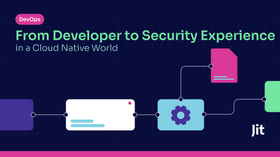Top 10 Vulnerability Management Tools
Updated July 14, 2025

Vulnerabilities don’t start in production anymore. They are baked into code, infrastructure configs, containers, and pipelines. By the time software hits production, your attack surface has already taken shape. Yet many teams still rely on traditional vulnerability management platforms, bulky systems built for static environments and quarterly scans.
Over 21,000 CVEs have been published so far in 2025, averaging 131 new vulnerabilities daily (up 16% from 2024). With attacks weaponized within 24 hours and the average time to remediation still hovering at over four months, the industry is overdue for a change.
That’s why the new generation of vulnerability management tools is built for real-time, developer-centric security, from pull request to runtime. Below, we list the top 10 tools designed for this new reality.
Top Vulnerability Management Tools at a Glance
- Best overall vulnerability management tool: Jit
- Best for cloud-first organizations managing sprawling environments: Wiz
- Best for enterprises with cloud-native and legacy infrastructure: Palo Alto Prisma Cloud
- Best for smaller engineering teams or startups: Intruder
- Best for GitOps environments: Kubescape
- Best for large enterprises with mature SOCs: Cisco Vulnerability Management
- Best for organizations prioritizing compliance: Qualys VMDR
- Best secrets scanner: Gitleaks
- Best for centralized triage: DevOcean
- Best AI-powered scanner: Semgrep
What Are Vulnerability Management Tools?
Vulnerability management tools systematically identify, assess, prioritize, and remediate security weaknesses in modern software systems. These tools typically scan source code, third-party packages, containers, infrastructure-as-code, and running cloud workloads, flagging issues tied to public CVEs or custom-defined policies.
At their core, these tools automate the discovery of known vulnerabilities (often via CVE databases), but modern solutions go far beyond passive scanning. They hook into CI/CD pipelines, development environments, and version control platforms to enable continuous assessment without disrupting developer flow.
Most leading tools now offer scanner orchestration across software composition analysis, static testing, dynamic testing, and IaC layers, normalize and deduplicate findings, and feed enriched results into existing issue management and collaboration systems.
That integration makes vulnerability management a core part of your DevSecOps strategy: enforcing policies, accelerating response, and improving the signal-to-noise ratio of security alerts.
Benefits of Modern Vulnerability Management Tools
1. Catch Issues Early
The average vulnerability is exploitable within 15 days of discovery, but patching often takes months. Modern tools scan early and frequently: at the pull request level, on each CI/CD run, and infrastructure commits. This early detection drastically reduces mean time to remediation (MTTR), limiting the window for attackers to exploit known issues.
2. Enable Developer-Driven Security
Security teams can’t fix everything alone. Developer-first tools embed feedback directly into GitHub PRs or GitLab MRs, including annotated risk summaries and suggested fixes. They empower engineers to remediate early and autonomously, without leaving their workflow.
3. Consolidate Fragmented Tooling
Most teams already use multiple scanners but struggle to unify their outputs. AppSec tools like Jit unify these scanners under a single interface, normalizing outputs into a shared language with consistent scoring and ownership. They streamline triage and make reporting cleaner and more actionable across teams.
4. Prioritizing What Matters
Vulnerability management tools move beyond CVSS baselines to incorporate runtime telemetry, asset criticality, and real-time threat intelligence. Instead of flagging every low-risk issue, they apply contextual scoring, factoring in exposure paths, user roles, and service interdependencies, to spot vulnerabilities that represent genuine, exploitable risk.
5. Scale Without Adding Security Headcount
Modern platforms help lean security teams cover more ground while improving developer productivity metrics. By codifying policies, automating remediation workflows, and integrating with collaboration tools like Jira and Slack, they reduce the manual burden of triaging security findings across teams. With AI agents like Jit’s COTA and SERA, you can even automate ticket routing and prioritization based on severity and team ownership.
Key Features to Look For in Vulnerability Management Tools
CI/CD Pipeline Integration: Choose tools that natively integrate with your CI/CD stack, be it GitHub Actions, GitLab CI, Bitbucket Pipelines, Jenkins, or CircleCI. They should enable scanning on every push, pull request, and deploy.
Security-Plans-as-Code: Security-plans-as-code allow you to define and version your security policies like infrastructure. These codified policies can be shared, audited, and reused, making security predictable and scalable.
Orchestration of Multiple Scanners: Look for platforms that unify results from various tools into a single interface with normalized severity, timelines, and fix workflows.
Exploitability-Based Prioritization: Instead of relying solely on CVSS scores, tools should factor in runtime exploitability, package usage, and external threat intel to help you triage more intelligently.
Inline Feedback for Developers: The best developer experience is one where security findings are presented alongside the code, inside PRs, with clear messages and auto-fix options. This drives faster resolution and higher adoption.
Top 10 Vulnerability Management Tools
Why “Good Enough” Vulnerability Management Isn’t Good Enough
Modern vulnerability management must reflect how software is built today: rapidly, collaboratively, and continuously. Security tools need to support that cadence, not hinder it. The platforms in this list help teams fix real issues faster by embedding directly into workflows, enriching context, and reducing friction across environments.
Jit addresses a critical gap in vulnerability management: turning detection into meaningful, contextual remediation. It embeds directly into the CI/CD process with security-as-code plans that define when and how scanners like Semgrep, Trivy, and Gitleaks are triggered, ensuring coverage across code, dependencies, IaC, and runtime. It also leverages a trio of AI agents to accelerate triage, cut response time, and reduce the manual load on security and engineering.
If you want to tighten your vulnerability management workflow without dragging down deployment speed, explore Jit here.






